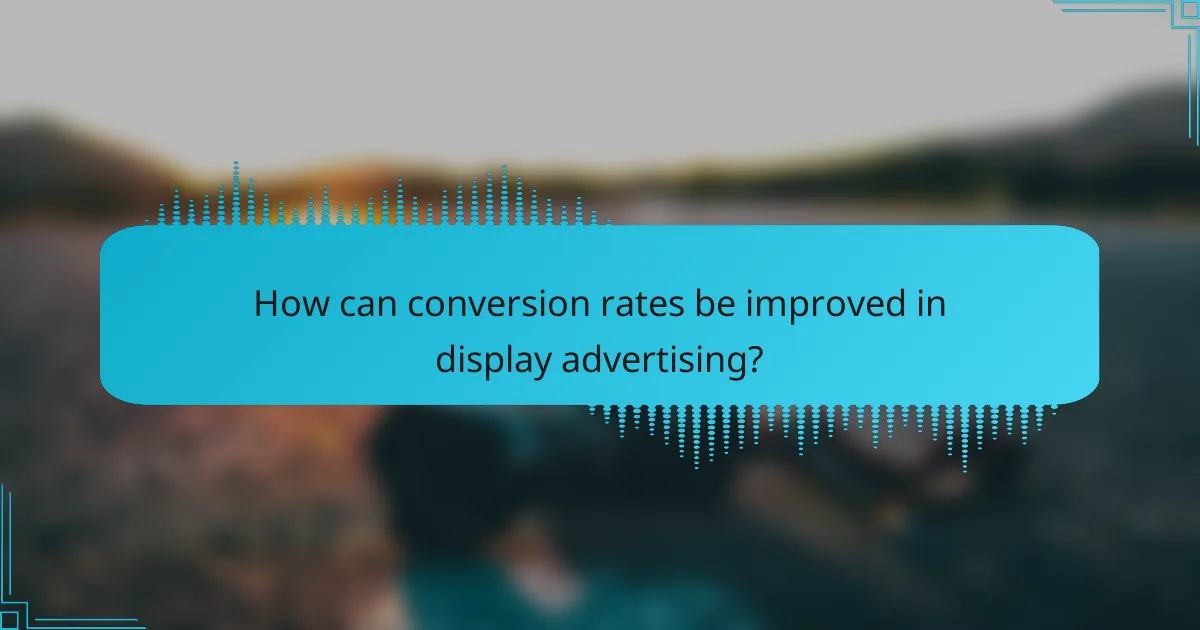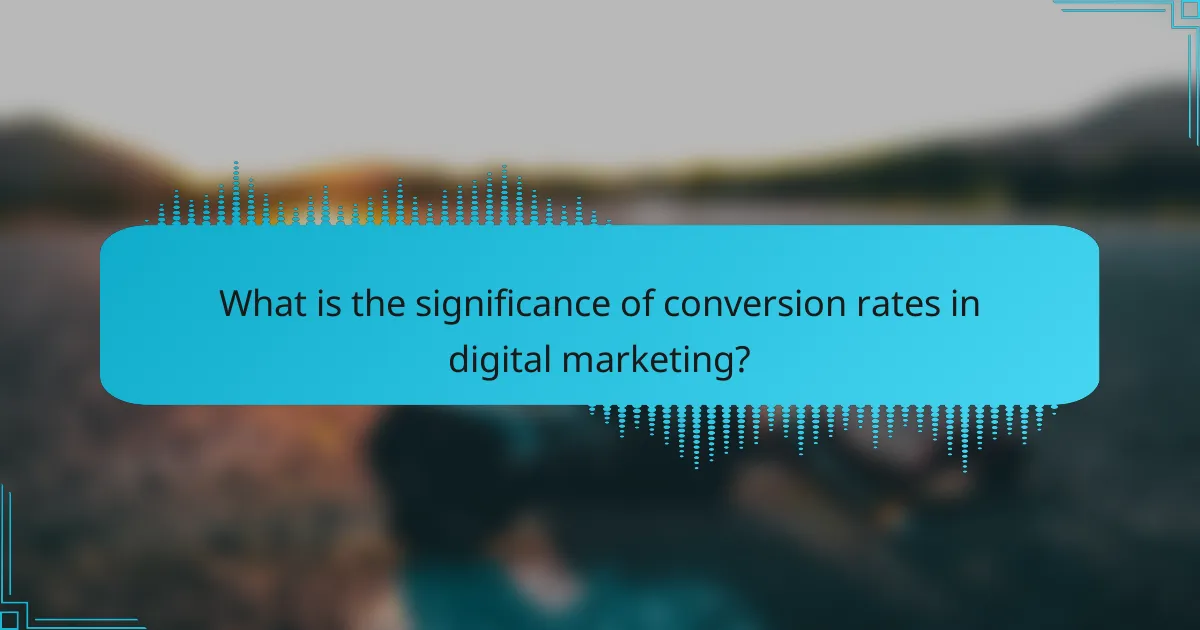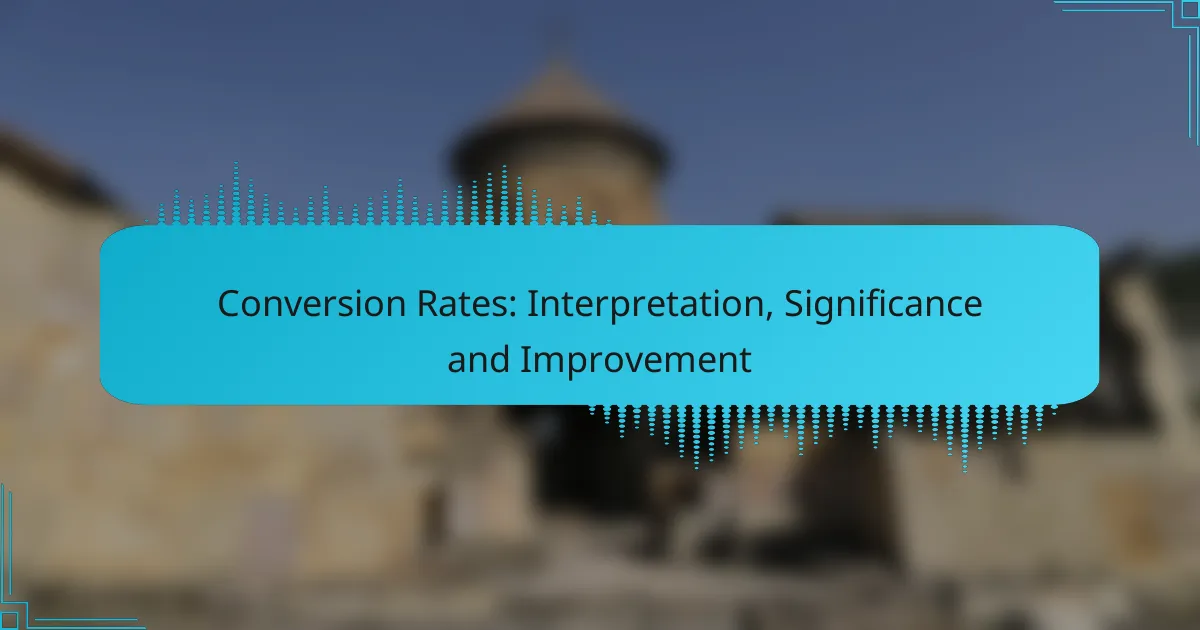Conversion rates are essential indicators of a digital marketing campaign’s success, reflecting how effectively a website transforms visitors into customers. By analyzing and improving factors such as ad placements, audience targeting, and landing page optimization, businesses can significantly enhance engagement and drive higher conversions, ultimately leading to increased revenue and customer loyalty.

How can conversion rates be improved in display advertising?
Improving conversion rates in display advertising involves strategic adjustments to ad placements, creatives, audience targeting, and retargeting efforts. By focusing on these areas, advertisers can enhance engagement and drive more conversions effectively.
Optimizing ad placements
Ad placements significantly influence visibility and engagement. Positioning ads in high-traffic areas of a website or app, such as above the fold or within content, can lead to better performance. Consider testing various placements to identify which locations yield the highest click-through rates.
Additionally, ensure that ads are displayed on relevant websites that align with your target audience’s interests. Using tools to analyze placement performance can help refine strategies and maximize ROI.
Enhancing ad creatives
Compelling ad creatives are essential for capturing attention and driving conversions. Use eye-catching visuals, clear messaging, and strong calls to action to entice users. Experiment with different formats, such as video or interactive ads, to see which resonates best with your audience.
Keep in mind that ad creatives should be tailored to the platform and audience. A/B testing different designs can provide insights into what elements work best, allowing for continuous improvement.
Utilizing A/B testing
A/B testing is a powerful method for optimizing conversion rates. By comparing two versions of an ad—such as different headlines or images—you can determine which performs better. This data-driven approach allows for informed decisions that enhance ad effectiveness.
When conducting A/B tests, ensure that you have a sufficient sample size and run tests for an adequate duration to gather reliable results. Regularly testing and iterating on ad elements can lead to sustained improvements.
Targeting specific audience segments
Targeting specific audience segments allows for more personalized advertising, which can significantly boost conversion rates. Use demographic, behavioral, and psychographic data to create tailored ads that speak directly to the needs and interests of different groups.
Consider leveraging tools like lookalike audiences or interest-based targeting to reach potential customers who are likely to engage with your ads. This focused approach can lead to higher engagement and conversion rates compared to broad targeting strategies.
Implementing retargeting strategies
Retargeting strategies are effective for re-engaging users who have previously interacted with your brand. By displaying ads to users who visited your website or engaged with your content, you can remind them of your offerings and encourage conversions.
To implement retargeting successfully, segment your audience based on their previous interactions. For example, create different campaigns for users who abandoned their shopping carts versus those who viewed specific products. This tailored approach can enhance the likelihood of conversion.

What is the significance of conversion rates in digital marketing?
Conversion rates are crucial metrics in digital marketing that indicate the effectiveness of campaigns in turning visitors into customers. A higher conversion rate signifies successful engagement and can lead to increased revenue and brand loyalty.
Measure of advertising effectiveness
Conversion rates serve as a direct measure of how well advertising efforts translate into actual sales or desired actions. By analyzing these rates, marketers can determine which campaigns are performing well and which need adjustments. For instance, a campaign with a conversion rate of 2-5% may be considered effective, while rates below 1% often indicate a need for reevaluation.
To improve advertising effectiveness, regularly test different ad formats, messaging, and targeting strategies. A/B testing can help identify which elements resonate best with your audience, leading to higher conversion rates.
Indicator of user engagement
Conversion rates are also a strong indicator of user engagement on a website. A high conversion rate often reflects that visitors find the content relevant and compelling enough to take action. For example, an e-commerce site with a conversion rate of 3% suggests that a significant portion of visitors are interested in purchasing products.
To enhance user engagement, focus on optimizing website design, improving load times, and ensuring a seamless user experience. Engaging content, clear calls-to-action, and personalized recommendations can further boost interaction and conversions.
Impact on ROI
Conversion rates directly impact return on investment (ROI) in digital marketing. Higher conversion rates typically lead to increased sales without a proportional increase in marketing costs, thus improving overall profitability. For example, if a campaign generates $10,000 in sales with a conversion rate of 4%, the ROI can be significantly higher compared to a campaign with a 1% conversion rate.
To maximize ROI, continuously analyze conversion data and adjust strategies accordingly. Focus on high-performing channels and allocate budget effectively to those that yield the best results, ensuring that marketing efforts are both efficient and impactful.

What factors influence conversion rates?
Conversion rates are affected by various factors that impact how effectively a website turns visitors into customers. Key elements include website usability, ad relevance, and landing page optimization, each playing a crucial role in the overall user experience and decision-making process.
Website usability
Website usability refers to how easy and intuitive a site is for users to navigate. A well-structured site with clear menus, fast loading times, and mobile responsiveness can significantly enhance user experience, leading to higher conversion rates. Aim for a loading time under three seconds and ensure that essential information is accessible within a few clicks.
Common usability pitfalls include cluttered layouts, broken links, and confusing navigation. Regularly testing your site with real users can help identify these issues and improve overall usability. Tools like heatmaps can provide insights into user behavior, allowing for targeted adjustments.
Ad relevance
Ad relevance is the degree to which your advertisements align with the interests and needs of your target audience. High relevance increases the likelihood that users will click on your ads and subsequently convert. Ensure that your ad copy, visuals, and landing pages are cohesive and tailored to the audience’s expectations.
To improve ad relevance, conduct thorough keyword research and utilize audience segmentation. A/B testing different ad variations can also help determine which messages resonate best with potential customers, leading to better performance and higher conversion rates.
Landing page optimization
Landing page optimization involves refining the specific pages where users arrive after clicking an ad or link to maximize conversions. Key elements include compelling headlines, clear calls to action, and persuasive content that addresses user pain points. Aim for a conversion rate of 20-30% for well-optimized landing pages.
Consider using A/B testing to evaluate different layouts, colors, and messaging. Additionally, ensure that your landing page loads quickly and is mobile-friendly, as many users access sites via smartphones. Avoid distractions and keep forms short to encourage user engagement and completion.

What are common misconceptions about conversion rates?
Misconceptions about conversion rates can lead to misguided strategies and ineffective marketing efforts. Understanding these myths is essential for accurately interpreting conversion data and implementing effective improvements.
Higher traffic guarantees higher conversions
Many believe that simply increasing website traffic will automatically lead to higher conversion rates. However, this is not necessarily true; the quality of the traffic is crucial. Targeted traffic that aligns with your audience’s interests and needs is more likely to convert than a large volume of irrelevant visitors.
For instance, a website attracting thousands of visitors from unrelated sources may see low conversion rates, while a site with fewer, but highly relevant visitors could achieve significantly higher conversions. Focus on attracting the right audience rather than just increasing numbers.
All conversions are equal
Not all conversions hold the same value for a business. A conversion could be a newsletter signup, a product purchase, or a request for a demo, each with different implications for revenue and customer engagement. Understanding the type of conversion is essential for evaluating its impact on your business goals.
For example, a purchase conversion typically has a higher value than a signup for a newsletter. Businesses should prioritize conversions that align with their strategic objectives and assess their performance accordingly.
Conversion rates are static
Another common misconception is that conversion rates remain constant over time. In reality, conversion rates can fluctuate due to various factors such as seasonality, changes in consumer behavior, or modifications to the website. Regularly monitoring and analyzing these rates is essential for identifying trends and making informed adjustments.
To improve conversion rates, businesses should conduct A/B testing, analyze user feedback, and adapt their strategies based on performance data. This proactive approach helps maintain and enhance conversion rates over time, ensuring they reflect current market conditions and user preferences.

How do cultural factors affect conversion rates in India?
Cultural factors significantly influence conversion rates in India by shaping consumer behavior and preferences. Understanding these elements can help businesses tailor their marketing strategies to resonate with local audiences, ultimately improving conversion outcomes.
Local preferences in ad content
In India, local preferences play a crucial role in determining the effectiveness of advertising content. Ads that reflect regional values, traditions, and lifestyles tend to perform better. For instance, using relatable scenarios or familiar cultural references can enhance engagement and drive conversions.
Brands should consider incorporating local festivals, customs, and social norms into their messaging. This approach not only builds trust but also fosters a sense of community, making consumers more likely to respond positively to the ad.
Regional language considerations
India is a linguistically diverse country with numerous regional languages. Using the local language in advertisements can significantly improve comprehension and relatability, leading to higher conversion rates. Brands should prioritize creating content in languages that resonate with their target demographic.
Additionally, employing colloquial phrases or idioms can make the communication feel more personal and engaging. This strategy can help bridge the gap between the brand and the consumer, enhancing the likelihood of a purchase.
Festive season impacts
The festive season in India presents unique opportunities and challenges for conversion rates. During major festivals like Diwali or Eid, consumer spending typically increases, and brands often see a surge in sales. Tailoring marketing campaigns to align with these festive occasions can lead to significant boosts in conversion rates.
It is essential for businesses to create special promotions or themed content that resonates with the festive spirit. However, competition also intensifies during this time, so brands must differentiate themselves through innovative strategies and compelling offers to capture consumer attention effectively.

What tools can help analyze conversion rates?
Several tools can effectively analyze conversion rates, providing insights into user behavior and website performance. These tools range from web analytics platforms to specialized conversion optimization software.
Google Analytics
Google Analytics is a widely used tool that tracks and reports website traffic, allowing users to analyze conversion rates through various metrics. It provides insights into user demographics, behavior flow, and conversion funnels, helping identify where users drop off in the purchasing process.
To effectively use Google Analytics for conversion analysis, set up goals that align with your business objectives. This could include tracking completed purchases, newsletter sign-ups, or contact form submissions. Regularly review these metrics to understand trends and make data-driven decisions.
Hotjar
Hotjar offers heatmaps, session recordings, and feedback polls, which help visualize user interactions on your site. By analyzing where users click, scroll, and spend time, you can identify areas for improvement that may enhance conversion rates.
Utilizing Hotjar’s feedback tools can also provide qualitative insights. For instance, you can ask users about their experience on specific pages, which can highlight pain points that hinder conversions. Implement changes based on this feedback to optimize user experience.
Optimizely
Optimizely is a robust A/B testing platform that allows businesses to experiment with different versions of their web pages. By testing variations of headlines, images, or layouts, you can determine which elements lead to higher conversion rates.
When using Optimizely, ensure that you have a clear hypothesis for each test and a sufficient sample size to achieve statistically significant results. This approach helps in making informed decisions that can significantly impact your conversion performance.
